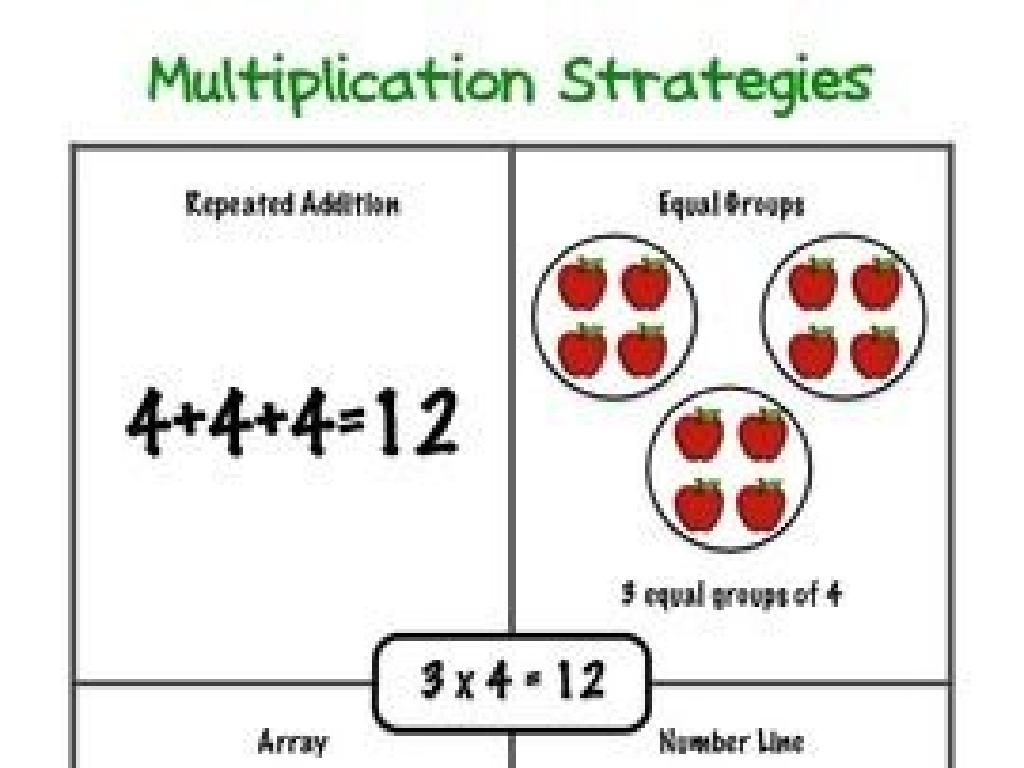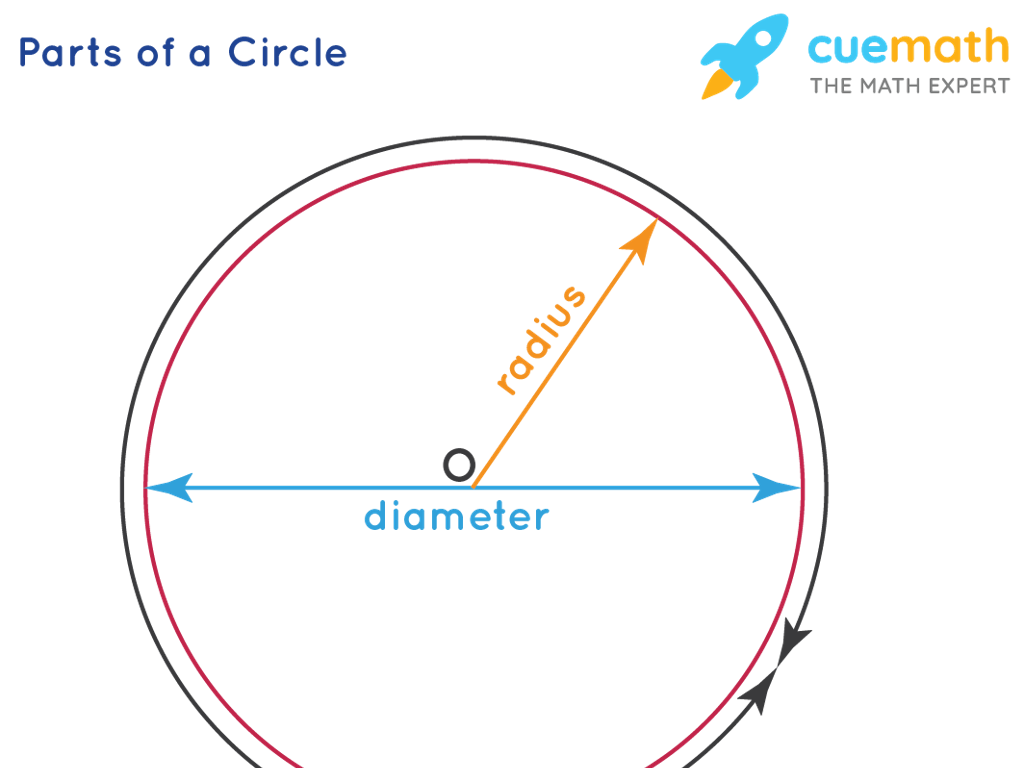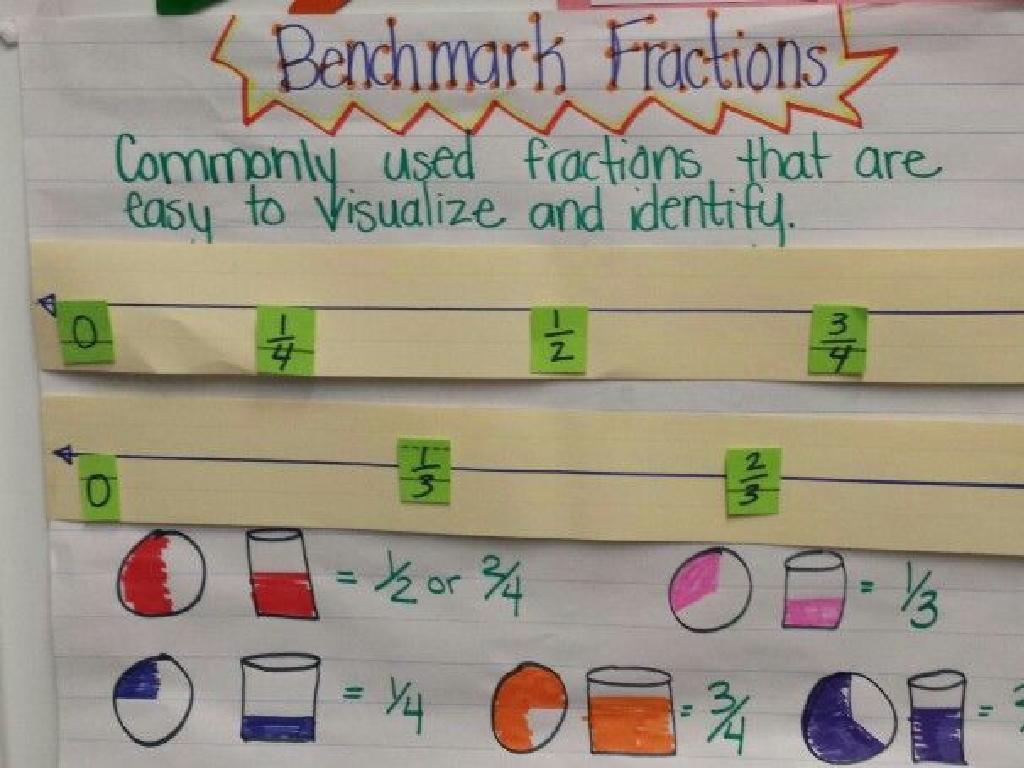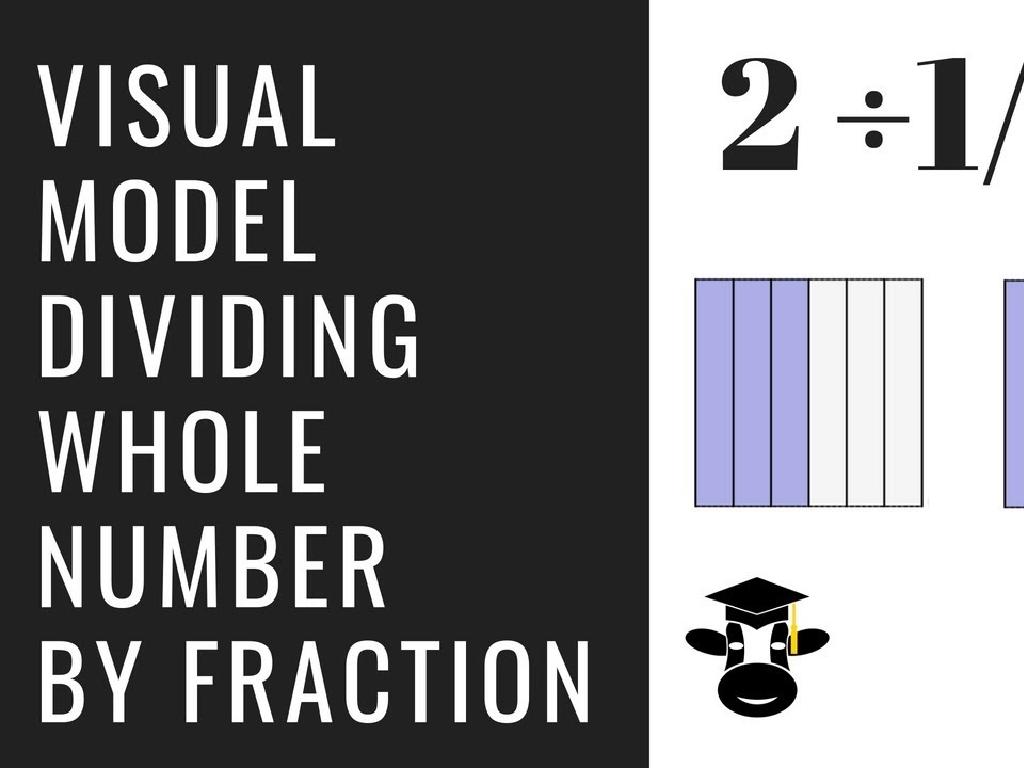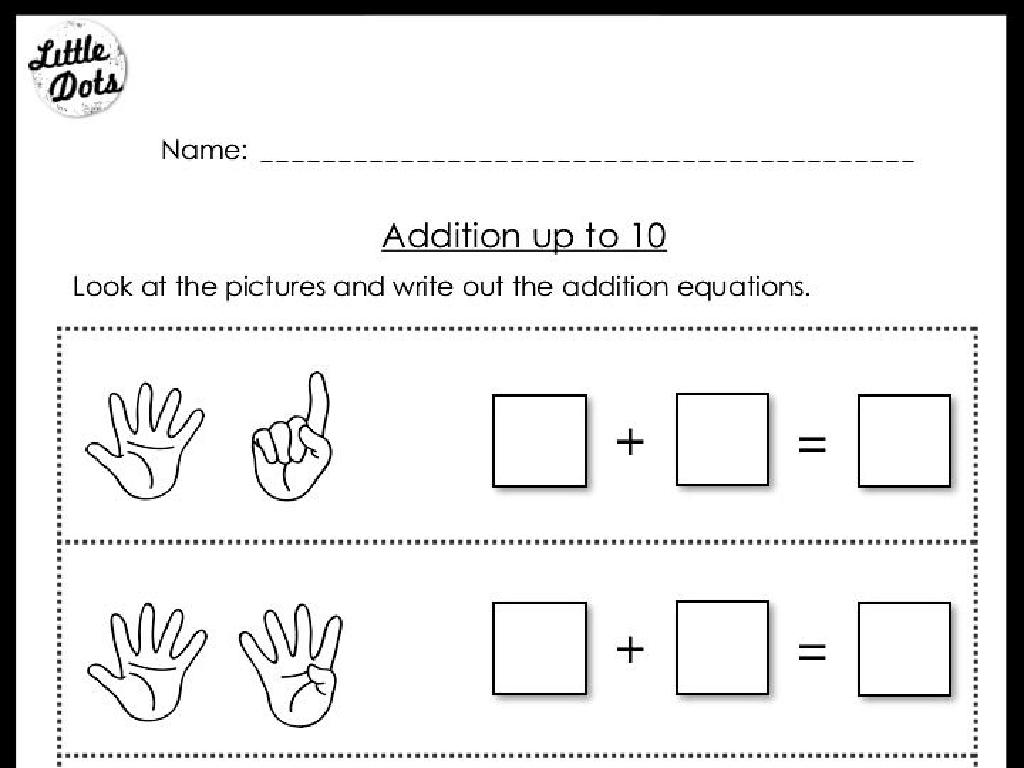Addition Sentences For Word Problems - Sums To 20
Subject: Math
Grade: Second grade
Topic: Addition: One Digit
Please LOG IN to download the presentation. Access is available to registered users only.
View More Content
Welcome to Addition!
– Becoming addition experts today
– Addition helps in daily life
– Like counting apples or sharing toys
– Writing addition sentences
– Turn stories into math problems
– Solving word problems with sums to 20
– Use numbers 0-20 to find answers
|
This slide introduces the concept of addition and its practicality in everyday situations for second graders. Emphasize the importance of addition in daily activities such as counting items or dividing things equally among friends. Explain that addition sentences are a way to translate real-life scenarios into mathematical problems that can be solved. Provide examples of simple word problems and demonstrate how to construct an addition sentence from them. Ensure that students understand that the sums will be within the range of 0 to 20. Encourage participation by asking students to come up with their own word problems and write the corresponding addition sentences. Prepare to guide them through the process of solving these problems in a step-by-step manner.
Understanding Addition Sentences
– What is an addition sentence?
– It’s like a math sentence with numbers and a plus sign.
– Example: 4 + 3 = 7
– This shows adding 4 and 3 makes 7.
– Combining numbers to find a sum
– When we put together two numbers, we get a new number.
– Practice with sums up to 20
– Let’s try adding numbers together and see what we get!
|
This slide introduces the concept of addition sentences to second-grade students. Start by explaining that an addition sentence is a mathematical way to show how two or more numbers combine to make a new number. Use simple examples like 4 + 3 = 7 to illustrate this point. Emphasize that the numbers being combined are called ‘addends’ and the result is called the ‘sum’. Encourage students to think of addition as combining groups of objects and to visualize this process. Provide several examples with sums up to 20 to ensure students are comfortable with the concept. As an activity, have students create their own addition sentences using objects in the classroom or drawn pictures.
Reading Word Problems: Finding Addition Clues
– Word problems tell a number story
– Find numbers to add in the story
– If a story says ‘5 apples and 3 oranges’, we add 5 + 3.
– Look for clues to add numbers
– Clues help us know when to add numbers.
– Words like ‘total’, ‘altogether’
– ‘Combined’ means to add things together, like 2 toys + 4 toys.
|
This slide introduces students to the concept of solving addition word problems with sums up to 20. Emphasize the importance of carefully reading the problem to understand the story being told and to identify the numbers involved. Highlight key vocabulary words that often indicate an addition problem, such as ‘in total’, ‘altogether’, and ‘combined’. Use simple, relatable examples to illustrate these clues, and encourage students to practice by reading out loud and discussing sample problems as a class. The goal is for students to become comfortable with recognizing when and how to form addition sentences from word problems.
Creating Addition Sentences from Word Problems
– Turn word problems into addition sentences
– Find numbers to add together
– Look for numbers in the story
– Write numbers with plus and equals signs
– Use ‘+’ for adding, ‘=’ for the total
– Example: 2 apples + 3 apples = 5 apples
– If Tom has 2 apples and gets 3 more, how many does he have now?
|
This slide introduces students to the concept of creating addition sentences from word problems, which is a fundamental skill in second-grade math. Start by explaining that word problems tell a story that involves adding things together. Show them how to identify the numbers in the problem that need to be added. Then, demonstrate how to write these numbers in a sentence format using a plus sign to show addition and an equals sign to show the result. Use simple, relatable examples, such as combining groups of apples, to illustrate the concept. Encourage students to practice with different word problems and to share their sentences with the class. This will help them understand how to apply addition to real-life situations.
Adding with Word Problems: Sums to 20
– Read the problem together
– Identify numbers to add
– Find numbers in the story: 5 apples, 3 oranges
– Write the addition sentence
– Translate story to math: 5 apples + 3 oranges
– Solve for the total sum
– Add the numbers: 5 + 3 equals what?
|
This slide is aimed at helping second-grade students understand how to form and solve addition sentences from word problems with sums up to 20. Start by reading the problem aloud with the class, ensuring they understand the context. Next, guide them to identify the relevant numbers within the problem. Then, demonstrate how to translate the word problem into an addition sentence. Finally, work through the addition sentence together to find the total sum. Encourage students to use their fingers or manipulatives to count if needed. The example provided uses simple numbers and familiar objects (apples and oranges) to ensure the concept is accessible to all students. Reinforce the idea that word problems tell a story that can be solved with math.
Let’s Practice Together: Addition Word Problems
– I’ll show you a word problem
– Look for numbers and keywords
– Keywords like ‘in total’ or ‘altogether’ hint at addition
– Write the matching addition sentence
– For example, ‘5 apples and 3 apples makes how many apples?’
– We’ll solve it as a team
|
This slide is designed to engage students in a collaborative problem-solving activity. Start by presenting a simple word problem to the class, ensuring it involves a sum less than or equal to 20. Guide the students to identify the numbers involved in the problem as well as keywords that indicate the operation is addition. Encourage them to translate the word problem into an addition sentence, such as ‘5 + 3 = ?’ for the example given. Work through the problem together, allowing students to suggest steps and solutions, and confirm the correct answer as a group. This activity will help reinforce their understanding of addition within 20 and improve their ability to interpret word problems.
Your Turn to Solve: Addition Word Problems
– Read the word problem carefully
– Find the numbers to add together
– Look for keywords like ‘total’, ‘together’, or ‘sum’
– Write the addition sentence
– Example: If you have 3 apples and 2 more, write ‘3 + 2 =’
– Check your work for accuracy
– Make sure your answer makes sense with the problem
|
This slide is an interactive activity for students to practice solving addition word problems with sums up to 20. Encourage students to read the problem multiple times to understand it fully. Teach them to identify key phrases that indicate addition. Once they find the numbers, they should write down the addition sentence, such as ‘3 + 2 = 5’. After writing the sentence, students should review their work to ensure the sum is correct and that it answers the question posed by the problem. Provide several examples of word problems for students to solve, and be ready to assist anyone who needs help. This activity will help reinforce their understanding of addition within 20 and improve their problem-solving skills.
Sharing Our Addition Sentences
– Share your addition sentences
– Explain your solution process
– How did you figure out the answer? Did you use objects, fingers, or mental math?
– Discuss different solving strategies
– Some may count on, use doubles, or make a ten to solve problems.
– Learn from classmates’ methods
– Hearing different approaches helps us all become better at adding.
|
This slide is designed for a class activity where students will engage with each other by sharing their addition sentences and the strategies they used to find the answers. Encourage students to be clear in their explanations, whether they used physical objects, counting on fingers, or mental math to reach their sums. Highlight the importance of understanding various methods, such as counting on, using doubles, or making a ten, as different strategies can be more effective for different problems. The teacher should facilitate the discussion, ensuring that each student has the opportunity to share and listen. The goal is for students to learn from one another, gaining insight into diverse ways of problem-solving within the realm of addition up to 20.
Class Activity: Addition Relay
– We’re playing an addition game!
– Work in groups on word problems
– Solve problems together and help each other
– Race to write answers on the board
– Take turns running and writing answers
– First team with correct solutions wins!
|
This activity is designed to make learning addition fun and interactive. Divide the class into small groups and provide each with a set of word problems that sum up to 20. Each group will work together to solve a problem, and then one member will run to the board to write the answer. The first team to finish all problems correctly wins a small prize. This encourages teamwork, active participation, and reinforces addition skills. Possible variations include a relay where each student solves a different problem, or a ‘math scavenger hunt’ where problems are hidden around the room.
Great Work on Addition!
– Congratulations on your hard work
– Homework: Solve worksheet problems
– Tackle word problems to apply today’s lesson
– Practice addition sentences at home
– Keep practicing to become an addition expert
– Aim for sums up to 20
|
This slide is meant to wrap up the lesson on addition sentences for word problems with sums up to 20. It serves as positive reinforcement for the students’ efforts during the class and sets expectations for homework. The homework consists of a worksheet with additional word problems that will help students apply what they’ve learned. Encourage them to practice regularly at home to improve their skills. As a teacher, you can suggest that parents assist their children if they struggle and remind them that making mistakes is part of the learning process. In the next class, review the homework to address any common issues and celebrate successes.

